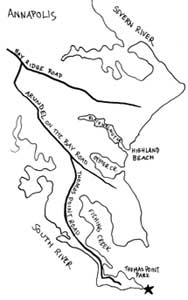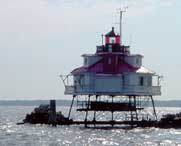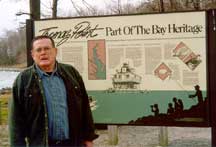|
|
 Marion Coomes 16 years caring for Thomas Point Park, neighbor to the most–photographed lighthouse on the Bay Marion Coomes 16 years caring for Thomas Point Park, neighbor to the most–photographed lighthouse on the Bay
by M.L. Faunce
Of Anne Arundel’s 266,000 acres, 5,000 acres are shared by us all as parks. The county’s list of 75 community and regional parks includes historical and archaeologically significant sites and sensitive natural areas.
Leading the system are four large regional parks: Quiet Waters Park, in Annapolis; Downs Park, in Pasadena; Kinder Farm Park, in Millersville; and Lake Waterford, also in Pasadena. At each of these, a superintendent lives in the park. It’s a perk for the ranger; security for the park.
Southern Anne Arundel has a small share of such riches. The biggest is Shady Side Park with its ballfields. Smaller are the Galesville Pier and Elizabeth Dixon Park, just big enough to watch sunsets; Deale Library Park and Deale/Tracy’s Park, which is only a small fishing pier; Friendship Pond, so small you must park along Old Solomons Island Road; and Rose Haven Waterfront Park, less than an acre with parking for four or five cars.
We’re lacking, too, in water access. In all its 432 miles of shoreline — which is just about how many square miles the county is — Anne Arundel has only one public beach for swimming and only two public boat ramps.
At two smaller park preserves, rangers under contract to provide security and maintenance also live on the grounds. Both Beverly-Triton Beach Park and Thomas Point Park are on the Bay at the South River.
Behind the residence of Ranger Marion Coomes at Thomas Point Park is a story …
Marion Coomes is a man of few words — especially when it comes to talking about himself. So others have spoken up for him, singing his praises for what he’s done as resident manager of Thomas Point Park.
For 16 years, Coomes has been caretaker of the 44-wooded acre spit of parkland at the mouth of the South River. The park is bounded by Fishing Creek and the South River and, at its jutting tip, looks out at the most photographed lighthouse on Chesapeake Bay.
But Thomas Point Shoal Lighthouse, the last screwpile lighthouse left on its original site in the Bay, isn’t the focus of area residents’ attention. It’s the job Coomes has done, in the words of park volunteer Bill Creath, “to transform the park into a delightful area.”
Under Coomes’ supervision and with his own hard labor from “sunrise to sunset,” nature trails and walkways have been laid, a pavilion and picnic area built with tables to accommodate wheelchairs, benches added at scenic overlooks, flowers planted and the small scout campground improved. The park, though heavily treed, is perfectly groomed.
 |
photos by M.L. Faunce
Thomas Point Park Ranger Marion and wife Carol Coomes, above, sit outside the park’s cabin, opposite, their home for 16 years. |
It’s “an ecological and scenic treasure,” says volunteer Creath.
Carol Coomes — wife and partner in many park projects — calls Thomas Point Park the “best-kept secret in Anne Arundel County.”
“Coomes has been a big asset,” says Brian Woodward, chief of Natural Resources for Anne Arundel County Parks and Recreation and supervisor of the so-called undeveloped parks: Thomas Point and Beverly-Triton Beach. “Thomas Point Park is one of the better kept parks, and Marion Coomes has done it all with smoke and mirrors.”
Cantankerous Times
It wasn’t always so. Those who have lived in the area long enough to remember say the former caretaker, “a cantankerous old soul,” would run people off with a shotgun. Then the park was virtually inaccessible to the public, with its gate often locked. This though the property was donated to Anne Arundel County in 1962 for “recreation and conservation purposes” by the Lee family, the previous owners.
 Residents and park supporters who use the park for walking, jogging, birding, fishing, picnicking and camping (Scout troops only) now think it’s the County Department of Parks and Recreation that’s being cantankerous. A year or so ago, the county informed Coomes and other resident caretakers that they would have to pay rent on their homes. Residents and park supporters who use the park for walking, jogging, birding, fishing, picnicking and camping (Scout troops only) now think it’s the County Department of Parks and Recreation that’s being cantankerous. A year or so ago, the county informed Coomes and other resident caretakers that they would have to pay rent on their homes.
Until tax laws changed, the house had been part of the compensation to resident rangers. The house’s becoming taxable “was a financial detriment to them,” said Woodward. “So now they have to pay a fair–market rent for the house.”
The Coomes had made their home in a small cabin that also doubles as the park office since 1986, when they moved there with son Patrick and daughter Kelly.
Resident rangers are hourly wage, “non-merit” county employees. The new policy to charge rent would have consumed half of Coomes’ salary.
 |
| photo by William Frece; courtesy of Department of Natural Resources. |
A Little Help from His Friends
Friends and users of the park, who say they were “appalled,” formed a committee. At a packed forum with county representatives they complained that the policy was tantamount to eviction for the long-time resident ranger and his family. Neighbors eventually persuaded the county to re-appraise the property and reduce the rent. But it was still more than Coomes could afford.
Response to Coomes’ plight was “overwhelming,” park neighbor and volunteer Ron Wilner said. Neighbors from nearby Oakwood, Watergate and Fishing Creek Farms and other friends of the park raised about 40 percent of the cost to subsidize a good friend and valuable asset, making sure that Coomes remains in residency and on the job until he retires, which could come as early as next year.
None of this will you hear from Marion Coomes: not a word about the county, not a breath about the former caretaker. “I just thought the people deserved more,” he says in his signature low-key manner.
The stocky former Marine and Korean-War vet — who still wears a 1950s’ crewcut — had another entire career working at Fort Meade. From 1969 to 1986, he was resident ranger at Lake Waterford Park in Pasedena. The Coomes have lived in parks all their married life.
At Thomas Point Park, just about everything is what he’s done, but not always single-handedly. On the day Bay Weekly followed Coomes as he went about his work, Chuck Meddles of Millersville was helping spread mulch. Taking a break from fishing on this windy March day — whitecaps pound on the riprap and the American flag whips wildly — Meddles said “friends of mine do more work here than I do.”
“My husband attracts some great volunteers,” Carol Coomes explains, as she ticks off a list of local folks and organizations, scouts and fly fishermen who have helped turn the park into a little-known gem.
As we talked, Coomes worked steadily on getting the point and pavilion ready for the Easter Sunrise services held by the Eastport Methodist Church each year.
“He is fanatical about keeping the park clean,” says his wife as her husband eyes errant leaves and the nemesis of all gardeners: the dratted sweet gum ball.
When neighbors Susan and Allan Fadden jog by with their dog Jasper, they stop long enough to bring up a favorite theme: how they wish Coomes would change his mind about retiring.
 |
| photo by M.L. Faunce |
When he does retire, Coomes says he’ll miss the park, but mostly he’ll miss the people. “We all get along,” he says.
Once Coomes retires, says Woodward, the county will re-evaluate how Thomas Point Park and the ranger’s house works.
It’s likely that the cabin that for 16 years has been the Coomes’ family home — without air conditioning but with a stiff wind on both warm and winter days — will be rented at market price to a tenant with no park responsibilities. Park supervision will come from Quiet Waters Park Superintendent Michael Murdock. The gate at the park entrance will be locked at night.
With no one on site, neighbors worry about security and possible vandalism. Coomes himself is concerned. “It’s a small park; anyone could come by land or water,” he says.
When asked what he was going to do when he retires and moves from the park to a house in Davidsonville, Coomes said, “find a lot to do.” That won’t come as a surprise to anyone who has known him, since that’s what he has always done at Thomas Point Park.
Thomas Point Park has very limited parking. Sixty vehicle permits — issued monthly from April through November for $10 — go as quickly as offered. The pavilion is popular for gatherings and weddings. Permits for up to 40 people cost $50. Walking and biking permits are free, as is the distant view of Thomas Point Shoal Lighthouse from the park’s tip.
In the 1970s, the county considered expanding the park to include soccer and baseball fields. The idea was abandoned because of the limited space and because of liability concerns.
The park is a favorite for anglers, and a special area is designated for fly fishing thanks to some quid pro quo and volunteer work done at the park by the Free State Fly Fishers Association. Camping is for recognized youth groups only.
Pets must be on a leash. Swimming, wading and alcohol are prohibited.
Follow Forest Drive east to Bay Ridge Road; turn right on Arundel on the Bay Road and continue to Thomas Point Road, driving slowly through the small neighborhoods.
Park hours are 8am–sunset daily. Office hours are 10am-Noon, W-Su: 410/222-1969.
Copyright 2002
Bay Weekly
|